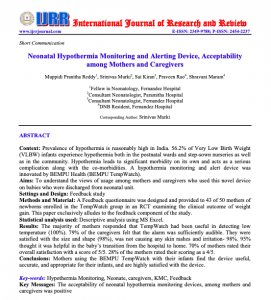Prevalence of hypothermia is reasonably high in India. 56.2% of Very Low Birth Weight (VLBW) infants experience hypothermia both in the postnatal wards and step-sown nurseries as well as in the community. Hypothermia leads to significant morbidity on its own and acts as a serious complication along with the co-morbidities. A hypothermia monitoring and alert device was innovated by BEMPU Health (BEMPU TempWatch).
Aims
To understand the views of usage among mothers and caregivers who used this novel device on babies who were discharged from neonatal unit.
Settings and Design
Feedback study.
Methods and Material
A Feedback questionnaire was designed and provided to 43 of 50 mothers of newborns enrolled in the TempWatch group in an RCT examining the clinical outcome of weight gain. This paper exclusively alludes to the feedback component of the study. Statistical analysis used: Descriptive analysis using MS Excel.
Results
The majority of mothers responded that TempWatch had been useful in detecting low temperature (100%). 79% of the caregivers felt that the alarm was sufficiently audible. They were satisfied with the size and shape (98%), was not causing any skin rashes and irritation- 98%. 95% thought it was helpful in the baby’s transition from the hospital to home. 70% of mothers rated their overall satisfaction with a score of 5/5. 28% of the mothers rated their scoring as a 4/5.
Conclusions
Mothers using the BEMPU TempWatch with their infants find the device useful, accurate, and appropriate for their infants, and are highly satisfied with the device.
